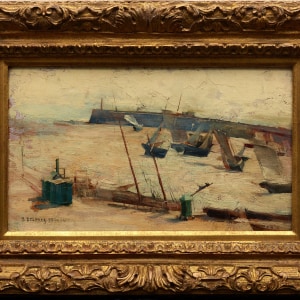Provenance
Private Collection, New Jersey
Catalogue note
This evocative seascape by Julie Delance-Feurgard captures a quiet yet atmospheric view of a harbor at low tide. Painted with a restrained but assured hand, the work depicts fishing boats resting against the quay, their sails slack and hulls leaning gently as the water recedes. The horizon is defined by a stone jetty that extends across the composition, anchoring the otherwise fluid rhythms of masts, rigging, and angular sails. The palette is characteristically subtle: muted ochres, sandy browns, and soft grays dominate the foreground, while touches of slate and umber enliven the boats and seawall. Above, the sky remains pale and overcast, its diffused light bathing the scene in a cool, almost melancholic tonality.
Delance-Feurgard, who trained at the Académie Julian in Paris under Jean-Léon Gérôme, Léon Bonnat, and her husband Paul-Louis Delance, was one of the rare women artists of her generation to pursue a professional career in painting. Like many of her contemporaries, she was drawn to subjects of everyday life, particularly those reflecting domesticity and labor. In Port à marée basse, her attention to the rhythms of the working harbor resonates with a broader nineteenth-century interest in naturalism and social realism, yet she approaches the scene not with overt drama but with quiet observation.
The harbor setting also reflects a personal dimension. Delance-Feurgard’s family roots traced back to Saint-Malo in Brittany, and maritime imagery would have been familiar and meaningful to her. This painting situates her within the tradition of French coastal painting that included Eugène Boudin and the Impressionists, while retaining her distinct voice. Where Boudin might have sought fleeting light effects, Delance-Feurgard emphasizes the materiality of place: stone, wood, and canvas are rendered with solidity, even as they are animated by the ebb and flow of the sea.
Port à marée basse reminds us of Delance-Feurgard’s versatility and her ambition to situate herself within the professional artistic world of her time. Exhibiting at the Salon from 1880 until her untimely death in 1892, she was recognized with honorable mentions at both the Salon and the Exposition Universelle of 1889. Though her career was tragically brief, works like this demonstrate her sensitivity to place, her command of pictorial structure, and her ability to imbue everyday scenes with poetic resonance. Today, they stand as rare and compelling testaments to the achievements of women artists in late nineteenth-century France.
This note was written by Elsa Dikkes.




